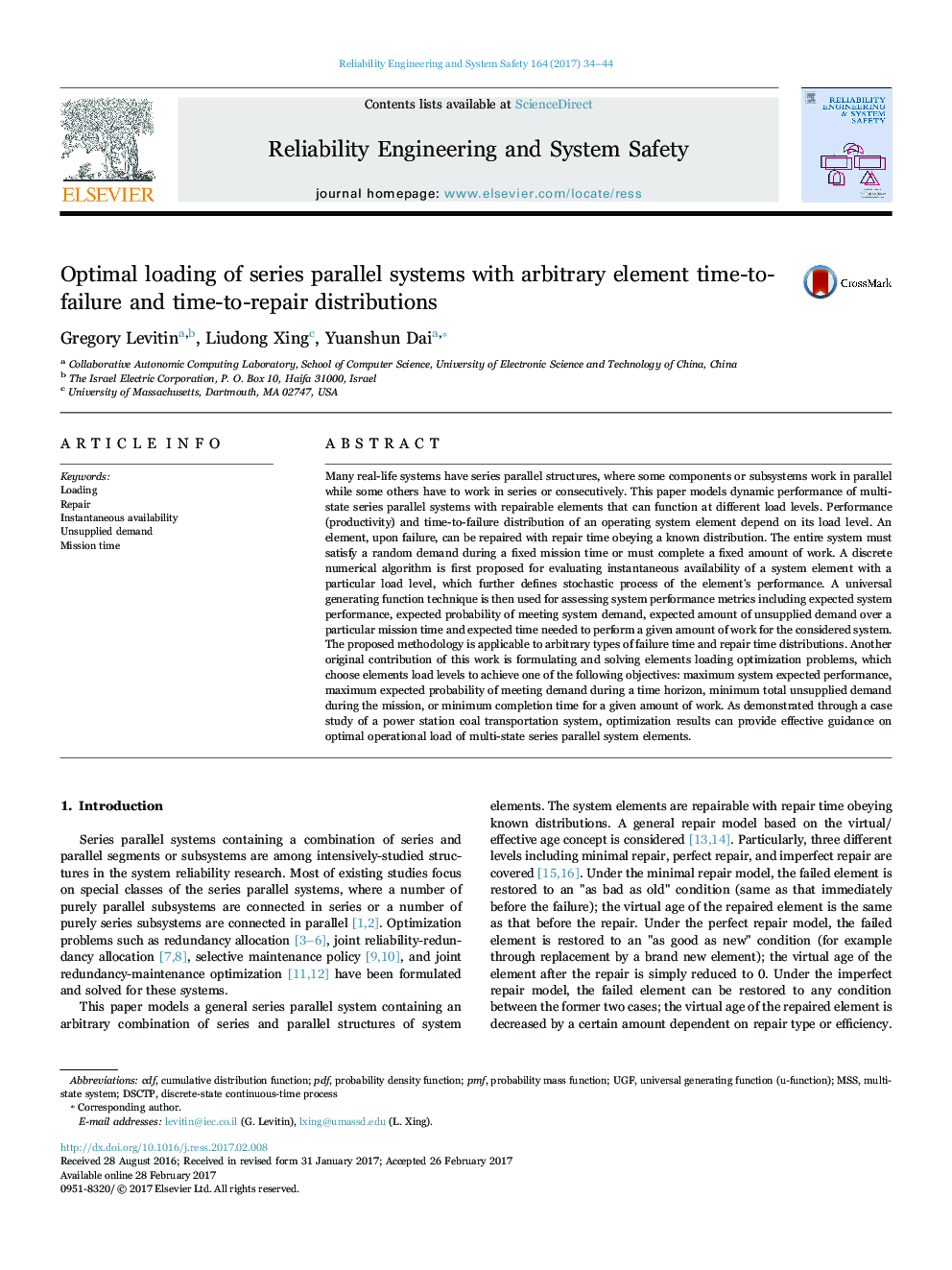| کد مقاله | کد نشریه | سال انتشار | مقاله انگلیسی | نسخه تمام متن |
|---|---|---|---|---|
| 5019445 | 1468206 | 2017 | 11 صفحه PDF | دانلود رایگان |
عنوان انگلیسی مقاله ISI
Optimal loading of series parallel systems with arbitrary element time-to-failure and time-to-repair distributions
ترجمه فارسی عنوان
بارگیری بهینه از سیستم های موازی سری با تخصیص زمان دلخواه به زمان وقوع خرابی و زمان به تعمیر
دانلود مقاله + سفارش ترجمه
دانلود مقاله ISI انگلیسی
رایگان برای ایرانیان
کلمات کلیدی
ترجمه چکیده
بسیاری از سیستم های زندگی واقعی دارای ساختارهای موازی سری هستند، در حالیکه بعضی از اجزای یا زیر سیستم ها به صورت موازی کار می کنند، در حالی که برخی دیگر باید به صورت سری و یا به صورت متوالی کار کنند. این مقاله مدل عملکرد دینامیکی سیستم های موازی سری چند حالته با عناصر قابل تعمیر که می تواند در سطوح بار مختلف عمل کند. عملکرد (بهره وری) و توزیع زمان به شکست یک عنصر عامل سیستم به میزان بار آن بستگی دارد. یک عنصر، پس از شکست، می تواند با زمان تعمیر با اطمینان از توزیع شناخته شده تعمیر شود. کل سیستم باید تقاضای تصادفی را طی یک ماموریت ثابت برآورده کند یا باید مقدار ثابت کار را کامل کند. اولا الگوریتم عددی گسسته برای ارزیابی در دسترس بودن لحظه ای از یک عنصر سیستم با یک سطح بار خاص است که فرآیند تصادفی عملکرد عنصر را بیشتر تعریف می کند. سپس یک تکنیک تابع تولید جهانی برای ارزیابی معیارهای عملکرد سیستم از جمله عملکرد سیستم مورد انتظار، احتمالات احتمالی تقاضای سیستم، مقدار مورد انتظار تقاضای غیرمستقیم برای یک زمان مشخص مأموریت و زمان انتظار برای انجام یک مقدار مشخص کار برای سیستم مورد نظر مورد استفاده قرار می گیرد. . روش پیشنهادی برای انواع دلخواه زمان شکست و توزیع زمان تعمیر قابل استفاده است. یکی دیگر از اهداف اصلی این کار، تشکیل و حل مشکلات بهینه سازی بارگذاری عناصر است که میزان بارگذاری عناصر را برای رسیدن به یکی از اهداف زیر انتخاب می کند: حداکثر عملکرد مورد انتظار سیستم، حداکثر احتمال انتظار برای پاسخگویی به تقاضا در طول افق زمانی، حداقل تقاضای تقاضای غیرمستقیم در طول دوره ماموریت، یا حداقل زمان اتمام برای یک مقدار معین از کار. همانطور که از طریق مطالعه موردی سیستم حمل و نقل زغال سنگ نیروگاه نشان داده شده است، نتایج بهینه سازی می تواند راهنمایی موثر در بار عملیاتی بهینه از عناصر سیستم سریال چند حالته ارائه دهد.
موضوعات مرتبط
مهندسی و علوم پایه
سایر رشته های مهندسی
مهندسی مکانیک
چکیده انگلیسی
Many real-life systems have series parallel structures, where some components or subsystems work in parallel while some others have to work in series or consecutively. This paper models dynamic performance of multi-state series parallel systems with repairable elements that can function at different load levels. Performance (productivity) and time-to-failure distribution of an operating system element depend on its load level. An element, upon failure, can be repaired with repair time obeying a known distribution. The entire system must satisfy a random demand during a fixed mission time or must complete a fixed amount of work. A discrete numerical algorithm is first proposed for evaluating instantaneous availability of a system element with a particular load level, which further defines stochastic process of the element's performance. A universal generating function technique is then used for assessing system performance metrics including expected system performance, expected probability of meeting system demand, expected amount of unsupplied demand over a particular mission time and expected time needed to perform a given amount of work for the considered system. The proposed methodology is applicable to arbitrary types of failure time and repair time distributions. Another original contribution of this work is formulating and solving elements loading optimization problems, which choose elements load levels to achieve one of the following objectives: maximum system expected performance, maximum expected probability of meeting demand during a time horizon, minimum total unsupplied demand during the mission, or minimum completion time for a given amount of work. As demonstrated through a case study of a power station coal transportation system, optimization results can provide effective guidance on optimal operational load of multi-state series parallel system elements.
ناشر
Database: Elsevier - ScienceDirect (ساینس دایرکت)
Journal: Reliability Engineering & System Safety - Volume 164, August 2017, Pages 34-44
Journal: Reliability Engineering & System Safety - Volume 164, August 2017, Pages 34-44
نویسندگان
Gregory Levitin, Liudong Xing, Yuanshun Dai,
